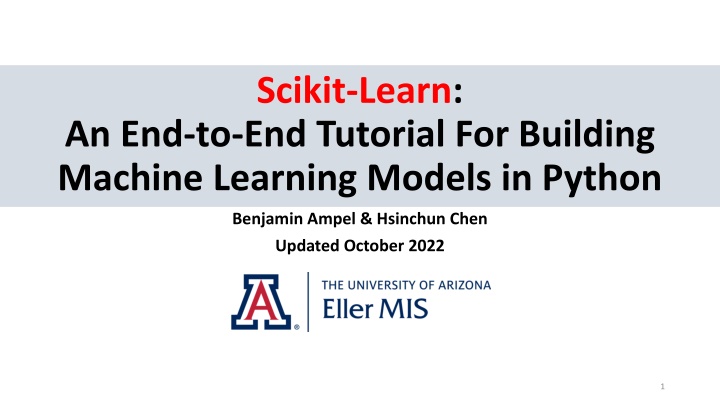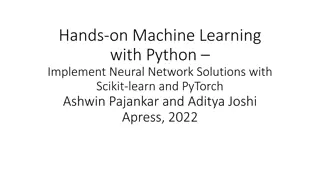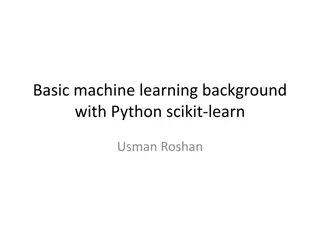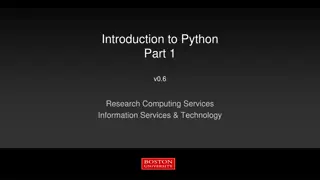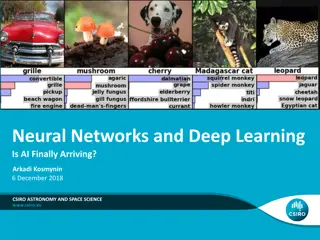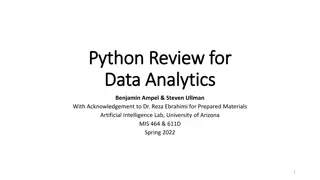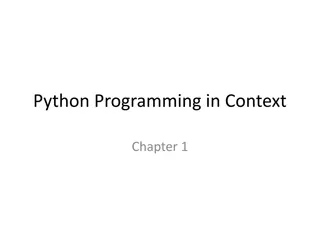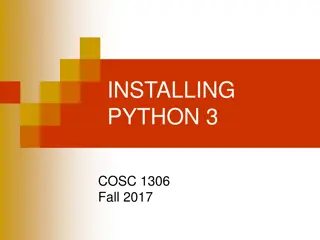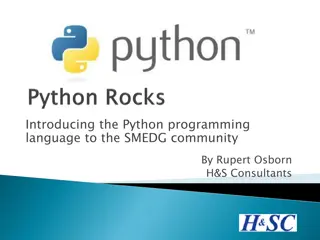Scikit-Learn Tutorial for Building Machine Learning Models in Python
Python's rise as a ubiquitous programming language has made data mining tasks easier with tools like scikit-learn. Learn how to set up the environment using Anaconda and Jupyter Notebook, load data, and work with feature matrices for classification and clustering tasks.
Download Presentation

Please find below an Image/Link to download the presentation.
The content on the website is provided AS IS for your information and personal use only. It may not be sold, licensed, or shared on other websites without obtaining consent from the author.If you encounter any issues during the download, it is possible that the publisher has removed the file from their server.
You are allowed to download the files provided on this website for personal or commercial use, subject to the condition that they are used lawfully. All files are the property of their respective owners.
The content on the website is provided AS IS for your information and personal use only. It may not be sold, licensed, or shared on other websites without obtaining consent from the author.
E N D
Presentation Transcript
Scikit-Learn: An End-to-End Tutorial For Building Machine Learning Models in Python Benjamin Ampel & Hsinchun Chen Updated October 2022 1
Introduction Introduction The rise of Python as a ubiquitous programming language has made it easier than ever to conduct data mining tasks. One of the most comprehensive packages for data mining is called scikit-learn. Originally released in 2010, scikit-learn has received continuous and free updates to benefit the data mining community. Scikit-learn can be used for tasks related to data cleaning, data transformation, classification, and clustering. 2
Environment Setup Environment Setup - - Anaconda Anaconda is an application that allows users to quickly and seamlessly build virtual Python environments tailored to their needs. To install, visit https://www.anaconda.com/products/distribution and download/install the correct version for your PC/Mac/Linux OS. Once downloaded, open Anaconda Navigator Make sure that Jupyter Notebook is installed and can be launched on the base screen. Click on Environments on the left panel. Then search and install scikit-learn, pandas, matplotlib, and NLTK. 3
Environment Setup Environment Setup - - Jupyter Notebook Jupyter Notebook Jupyter Notebook is an application that allows users to run their code in chunks. This allows for targeted coding; no need to run entire Python scripts over if there is a single error. To begin coding, launch Jupyter Notebook from Anaconda and create a new Python 3 Notebook. 4
Data Loading Data Loading Data mining data is usually represented with a feature matrix (very similar to an Excel spreadsheet or SQL table). Features Attributes used for analysis Represented by columns in feature matrix Instances Entity with certain attribute values Represented by rows in feature matrix An example instance is highlighted in red (also called a feature vector). Class Labels Indicate category for each instance. This example has two classes (C1 and C2). Only used for supervised learning. The Feature Matrix Features Attributes used to classify instances F1 F2 F3 F4 F5 41 1.2 2 1 3.6 C1 63 1.5 4 0 3.5 C2 Each instance has a class label 109 0.4 6 1 2.4 C1 34 0.2 1 0 3.0 C1 33 0.9 6 1 5.3 C1 565 4.3 10 0 3.2 C2 21 4.3 1 0 1.2 C1 35 5.6 2 0 9.1 C2 Instances 5
Data Loading Data Loading The most common formats to store data for data mining tasks are CSV, SQL, JSON, and XML. The Python package can process any of these data formats and place them into memory as a dataframe (df). A df acts similarly to an Excel spreadsheet, shown below in a Jupyter Notebook. 6
Exploratory Data Analysis Exploratory Data Analysis Most data is raw when loaded, meaning it is just the collected values. Before running statistical models, it is vital to understand the dataset. Pandas provides many different modules to perform exploratory data analysis (EDA). First, we should look at the missing values of the dataset and determine how many rows and columns contain missing (null) values. This can assist in finding trends in the data and determine if missing values are random or if they is a systematic reason for missing values. Additionally, note any features (columns) that only have one value. These should be deleted. Next, we should determine if there are outliers in our dataset. Outliers are values that fall outside of two standard deviations of the feature mean. Outliers can be univariate (only one feature is an outlier) or multivariate (when features are plotted together, a row becomes an outlier). 7
Exploratory Data Analysis Exploratory Data Analysis From a univariate perspective, we should analyze the distribution of the data. If the feature is categorical, analysis will look at the count, unique count, most frequent, and frequency of each column. 8
Exploratory Data Analysis Exploratory Data Analysis From a univariate perspective, we should analyze the distribution of the data. If the feature is continuous, analysis will look at the mean, standard deviation (std), minimum, and maximum values of each column. 9
Data Cleaning Data Cleaning Data Imputation Data Imputation Records in a dataframe that contain missing values need to be addressed before further processing. There are several strategies to deal with nulls: 1. Drop any record containing missing data df.dropna() 2. Heuristics (Domain expert makes reasonable guess) 3. Average (Fill in missing record with the average across the feature) df.fillna(df.mean()) 4. Prediction (Use an ML method to predict missing data) scikit-learn Once missing data has been dealt with, several feature engineering steps can be conducted using scikit-learn. 10
Data Cleaning Data Cleaning Feature Engineering Feature Engineering There are strategies to extract or transform interesting information from this raw data to be used an input feature: Scale: Normalize values based on log value, minmax scale, etc. Scaling large continuous variables (e.g., price) is vital to ensure that one feature does not dominate over other features. Import correct function Use MinMax scaler to scale continuous variable from 0-1 Define the column to normalize 11
Data Cleaning Data Cleaning Feature Engineering Feature Engineering Import correct function Classical machine learning models cannot take categorical data (e.g., Female ) natively. Therefore, we use label encoding to convert strings to corresponding numbers. With this data cleaning complete, we can now run machine learning (ML) classification models to predict which passengers survived the Titanic. Fit the label encoder to the data and transform it from categorical to numerical Define the column to normalize 12
ML Classification: Introduction ML Classification: Introduction ML classification models use a training process in which the model makes predictions and is corrected when those predictions are wrong. The training process continues until the model achieves a desired level of accuracy on the training data. A learned model can be used to predictfuturedata points with no known outcome. Given a set of data points {?1, ,??} with a set of known outcomes ?1, ,??, the goal is to train a model that can effectively predict any ? provided any ?. ML models learn a target function ? that best maps input variables ? to an output variable ?, or ? = ?(?). The ? should be categorical (or else it becomes a regression problem). 13
ML Classification: Train/Test Split ML Classification: Train/Test Split Training Data: The data used to fit your models, known as the set used for learning Validation Data: The data used to tune the parameters of a model Test Data: The data used to evaluate how good your model is. Your model does not see this data until final testing/evaluation to ensure it is generalizable to unseen data points. Figure Sourced From: Stanford CS 229 Machine Learning 14
ML Classification: Train/Test Split ML Classification: Train/Test Split Scikit-learn provides a function to split your data into training, testing, and validation groups. Import correct function Output two datasets Stratify maintains class proportions in training and testing datasets Test data should be about 25% of the dataset 15
ML Classification: Inputs/Outputs ML Classification: Inputs/Outputs Remember, a classification task uses a set of input variables ? to predict a known outcome ?. Therefore, we need to define the features that are inputs (?) and outputs (?) We want to predict who survived the Titanic Repeat for test data 16
ML Classification: Evaluation Metrics ML Classification: Evaluation Metrics Figure Sourced From: aqeel-anwar.com Accuracy: Ratio of correct predictions over total predictions Misleading when class sizes are substantially different. Precision: How often the classifier is correct when it predicts positive Recall: How often the classifier is correct for all positive instances F1-Score: Harmonic mean of Precision and Recall 17
Seminal ML Algorithms Seminal ML Algorithms Na ve Bayes Na ve Bayes The Na ve Bayes model uses prior probabilities of related events to predict future events. Called Na ve because assumption of independence between every pair of features. When your data is real-valued, it is common to assume a Gaussian distribution (bell curve) so that you can easily estimate probabilities. Figure Sourced From: aqeel-anwar.com 18
Seminal ML Algorithms Seminal ML Algorithms k k- -Nearest Neighbors Nearest Neighbors Predictions are made for a new data point by searching through the entire training set for the ? most similar instances (the neighbors) and summarizing the output variable for those ? instances. Similarity scores are determined via a simple distance calculation (e.g., Euclidean) The optimal value for ? can be found using cross validation. 19 Figure Sourced From: http://mavericklin.com/
Seminal ML Algorithms Seminal ML Algorithms Decision Trees Decision Trees DTs use a binary branching structure to classify an input vector ?. Each node in the tree contains a simple feature comparison Result of each comparison is either true or false, which determines if we should proceed along to the left or right child of the given node. Figure Sourced From: http://mavericklin.com/ 20
Seminal ML Algorithms Seminal ML Algorithms Support Vector Machines Machines SVMs aim to construct a hyperplane that separates points between two classes. Support Vector The hyperplane is determined by finding the hyperplane that is the maximum distance from the training observations. This distance is called the margin. Points that fall on one side of the hyperplane are classified as -1 and the other +1. Figure Sourced From: Stanford CS 229 Machine Learning 21
Seminal ML Algorithms Seminal ML Algorithms Results Results The code to the right creates a loop through the seminal ML models. Each model is trained, provided the test dataset, and metrics are calculated. The metrics for each model are output to a dataframe for readability. In the context of the titanic dataset, we find that the SVM performs best in accuracy, precision, recall, and F1- score. 22
ML Clustering: Introduction ML Clustering: Introduction What if our dataset does not have a set of known outcomes ?? Given a set of data points {?1, ,??}, the goal is to train a model that can effectively group together similar datapoints without a target label. This is known as clustering. Salient examples include clustering members of social networks into similar communities and clustering patients together based on similar symptoms. The seminal ML model for clustering is ?-Means, available in scikit- learn. 23
Seminal ML Algorithms Seminal ML Algorithms ?- -Means Means Given {?1, ,??}, ?-means aims to place them into ? clusters {?1, ,??} using an objective function defined as: ? 1 ?? 2 min ?1, ,?? ?? ?? ?=1 ?,? ?? Written plainly, the objective aims to minimize the sum of the squared error between data points in each cluster. This objective function should create tightly linked and clearly distinct clusters. Figure Sourced From: TowardsDataScience 24
Seminal ML Algorithms Seminal ML Algorithms ?- -Means Means The number of clusters must be defined by the user. How can we determine the optimal number of clusters to use for our dataset? Instead of manually determining the correct clusters (?), we can implement the elbow method to optimally find the correct ?. Remember, we want to minimize the sum of squared error (SSE). Therefore, we can iterate over different cluster sizes, calculate SSE, and find the ? that levels out the SSE curve (i.e., the elbow). 25
Seminal ML Algorithms Seminal ML Algorithms ?- -Means Means Clear elbow at 3 clusters In the above code, we load the standard Iris dataset, fit a ?-means model 10 times with 1-10 clusters, and plot the SSE for each model. We find that the elbow appears at three clusters. Therefore, we should create a ?-means model with ? = 3 and visualize our clusters. 26
Seminal ML Algorithms Seminal ML Algorithms ?- -Means Means The code above fits a ?-means model with three defined clusters. We cluster each data point into one of three clusters and plot the centroid (mean of the cluster). We find a clearly distinct red cluster, and slightly distinct blue and green clusters. 27
Summary Summary Scikit-learn is an all-in-one package to build powerful machine learning models. These models can be predictive (classification) or descriptive (clustering). Building these models does not require much coding experience, allowing the user to explore interesting models and new datasets with ease. 28
